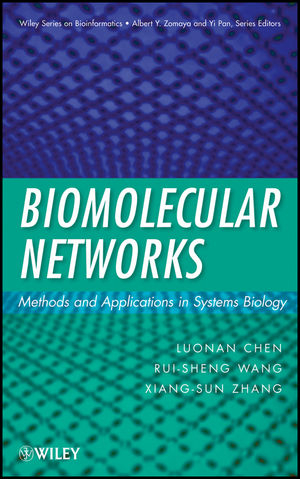
Biomolecular Networks
John Wiley & Sons Inc (Verlag)
978-0-470-24373-2 (ISBN)
- Titel z.Zt. nicht lieferbar
- Versandkostenfrei innerhalb Deutschlands
- Auch auf Rechnung
- Verfügbarkeit in der Filiale vor Ort prüfen
- Artikel merken
Alternative techniques and tools for analyzing biomolecular networks With the recent rapid advances in molecular biology, high-throughput experimental methods have resulted in enormous amounts of data that can be used to study biomolecular networks in living organisms. With this development has come recognition of the fact that a complicated living organism cannot be fully understood by merely analyzing individual components. Rather, it is the interactions of components or biomolecular networks that are ultimately responsible for an organism's form and function. This book addresses the important need for a new set of computational tools to reveal essential biological mechanisms from a systems biology approach.
Readers will get comprehensive coverage of analyzing biomolecular networks in cellular systems based on available experimental data with an emphasis on the aspects of network, system, integration, and engineering. Each topic is treated in depth with specific biological problems and novel computational methods:
GENE NETWORKS—Transcriptional regulation; reconstruction of gene regulatory networks; and inference of transcriptional regulatory networks
PROTEIN INTERACTION NETWORKS—Prediction of protein-protein interactions; topological structure of biomolecular networks; alignment of biomolecular networks; and network-based prediction of protein function
METABOLIC NETWORKS AND SIGNALING NETWORKS—Analysis, reconstruction, and applications of metabolic networks; modeling and inference of signaling networks; and other topics and new trends
In addition to theoretical results and methods, many computational software tools are referenced and available from the authors' Web sites. Biomolecular Networks is an indispensable reference for researchers and graduate students in bioinformatics, computational biology, systems biology, computer science, and applied mathematics.
LUONAN CHEN, PhD, is a full professor in the Department of Electrical Engineering and Electronics, Osaka Sangyo University, Osaka, Japan, and he is also the founding director of Institute of Systems Biology, Shanghai University, Shanghai, China. Dr. Chen's fields of interest include systems biology, bioinformatics, and nonlinear dynamics. RUI-SHENG WANG, PhD, is an assistant professor in the School of Information, Renmin University of China. Dr. Wang's research interests include bioinformatics, computational systems biology, and complex networks. XIANG-SUN ZHANG is a full research professor in the Institute of Applied Math-ematics, Chinese Academy of Sciences. Professor Zhang's research interests include bioinformatics, systems biology, optimization theory, and related computational mathematics.
PREFACE. ACKNOWLEDGMENTS.
LIST OF ILLUSTRATIONS.
ACRONYMS.
1 Introduction.
1.1 Basic Concepts in Molecular Biology.
1.2 Biomolecular Networks in Cells.
1.3 Network Systems Biology.
1.4 About This Book.
I GENE NETWORKS.
2 Transcription Regulation: Networks and Models.
2.1 Transcription Regulation and Gene Expression.
2.2 Networks in Transcription Regulation.
2.3 Nonlinear Models Based on Biochemical Reactions.
2.4 Integrated Models for Regulatory Networks.
2.5 Summary.
3 Reconstruction of Gene Regulatory Networks.
3.1 Mathematical Models of Gene Regulatory Network.
3.2 Reconstructing Gene Regulatory Networks.
3.3 Inferring Gene Networks from Multiple Datasets.
3.4 Gene Network-Based Drug Target Identification.
3.5 Summary.
4 Inference of Transcriptional Regulatory Networks.
4.1 Predicting TF Binding Sites and Promoters.
4.2 Inference of Transcriptional Interactions.
4.3 Identifying Combinatorial Regulations of TFs.
4.4 Inferring Cooperative Regulatory Networks.
4.5 Prediction of Transcription Factor Activity.
4.6 Summary.
II PROTEIN INTERACTION NETWORKS.
5 Prediction of Protein–Protein Interactions.
5.1 Experimental Protein–Protein Interactions.
5.2 Prediction of Protein–Protein Interactions.
5.3 Protein Interaction Prediction Based on Multidomain Pairs.
5.4 Domain Interaction Prediction Methods.
5.5 Summary.
6 Topological Structure of Biomolecular Networks.
6.1 Statistical Properties of Biomolecular Networks.
6.2 Evolution of Protein Interaction Networks.
6.3 Hubs, Motifs, and Modularity in Biomolecular Networks.
6.4 Explorative Roles of Hubs and Network Motifs.
6.5 Modularity Evaluation of Biomolecular Networks.
6.6 Summary.
7 Alignment of Biomolecular Networks.
7.1 Biomolecular Networks from Multiple Species.
7.2 Pairwise Alignment of Biomolecular Networks.
7.3 Network Alignment by Mathematical Programming.
7.4 Multiple Alignment of Biomolecular Networks.
7.5 Subnetwork and Pathway Querying.
7.6 Summary.
8 Network-Based Prediction of Protein Function.
8.1 Protein Function and Annotation.
8.2 Protein Functional Module Detection.
8.3 Functional Linkage for Protein Function Annotation.
8.4 Protein Function Prediction from High-Throughput Data.
8.5 Function Annotation Methods for Domains.
8.6 Summary.
III METABOLIC NETWORKS AND SIGNALING NETWORKS.
9 Metabolic Networks: Analysis, Reconstruction, and Application.
9.1 Cellular Metabolism and Metabolic Pathways.
9.2 Metabolic Network Analysis and Modeling.
9.3 Reconstruction of Metabolic Networks.
9.4 Drug Target Detection in Metabolic Networks.
9.5 Summary.
10 Signaling Networks: Modeling and Inference.
10.1 Signal Transduction in Cellular Systems.
10.2 Modeling of Signal Transduction Pathways.
10.3 Inferring Signaling Networks from High-Throughput Data.
10.4 Inferring Signaling Networks by Linear Programming.
10.5 Inferring Signaling Networks from Experimental Evidence.
10.6 Summary.
11 Other Topics and New Trends.
11.1 Network-Based Protein Structural Analysis.
11.2 Integration of Biomolecular Networks.
11.3 Posttranscriptional Regulation of Noncoding RNAs.
11.4 Biomolecular Interactions and Human Diseases.
11.5 Summary.
REFERENCES.
INDEX.
| Erscheint lt. Verlag | 28.7.2009 |
|---|---|
| Reihe/Serie | Wiley Series in Bioinformatics |
| Mitarbeit |
Herausgeber (Serie): Albert Y. Zomaya, Yi Pan |
| Verlagsort | New York |
| Sprache | englisch |
| Maße | 160 x 242 mm |
| Gewicht | 694 g |
| Themenwelt | Mathematik / Informatik ► Informatik ► Theorie / Studium |
| Naturwissenschaften ► Biologie | |
| Technik ► Elektrotechnik / Energietechnik | |
| ISBN-10 | 0-470-24373-2 / 0470243732 |
| ISBN-13 | 978-0-470-24373-2 / 9780470243732 |
| Zustand | Neuware |
| Haben Sie eine Frage zum Produkt? |
aus dem Bereich


